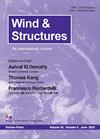超高层建筑外附塔式起重机的风振脆弱性研究
IF 1.9
4区 工程技术
Q3 CONSTRUCTION & BUILDING TECHNOLOGY
引用次数: 2
摘要
为了深入了解超高层建筑施工过程中与附着式塔吊相关的风致安全问题,选择了一座606 m水平的框架-核心筒超高层建筑,研究了外附着式塔吊在施工各个阶段的风致振动响应和易损性。人工生成风速时程样本,用于起重机的动态响应分析,以观察起重机在工作和非工作静止状态下风速和风向的影响。还确定了不同连接支撑处相对位移响应的不利影响。引入增量动力分析的概念,得到了起重机的抗风脆性曲线。研究结果表明,支架之间的较大相对位移可以显著放大起重机在高水平下的响应。当提升臂垂直于连接支撑件的平面时,这种影响变得更加严重。在外附塔式起重机的设计中,应考虑超高层建筑的灵活性,尤其是锚固系统。脆弱性分析可用于指定每个性能级别的塔式起重机的最大适当高度。本文章由计算机程序翻译,如有差异,请以英文原文为准。
Wind-induced vibration fragility of outer-attached tower crane to super-tall buildings: A case study
To gain insight into the wind-induced safety concerns associated with attached tower cranes during the construction of super-tall buildings, a 606 m level frame-core tube super-tall building is selected to investigate the wind-induced vibration response and fragility of an outer-attached tower crane at all stages of construction. The wind velocity time history samples are artificially generated and used to perform dynamic response analyses of the crane to observe the effects of wind velocity and wind direction under its working and non-working resting state. The adverse effects of the relative displacement response at different connection supports are also identified. The wind-resistant fragility curves of the crane are obtained by introducing the concept of incremental dynamic analysis. The results from the investigation indicate that a large relative displacement between the supports can substantially amplify the response of the crane at high levels. Such an effect becomes more serious when the lifting arm is perpendicular to the plane of the connection supports. The flexibility of super-tall buildings should be considered in the design of outer-attached tower cranes, especially for anchorage systems. Fragility analysis can be used to specify the maximum appropriate height of the tower crane for each performance level.
求助全文
通过发布文献求助,成功后即可免费获取论文全文。
去求助
来源期刊

Wind and Structures
工程技术-工程:土木
CiteScore
2.70
自引率
18.80%
发文量
0
审稿时长
>12 weeks
期刊介绍:
The WIND AND STRUCTURES, An International Journal, aims at: - Major publication channel for research in the general area of wind and structural engineering, - Wider distribution at more affordable subscription rates; - Faster reviewing and publication for manuscripts submitted.
The main theme of the Journal is the wind effects on structures. Areas covered by the journal include:
Wind loads and structural response,
Bluff-body aerodynamics,
Computational method,
Wind tunnel modeling,
Local wind environment,
Codes and regulations,
Wind effects on large scale structures.
 求助内容:
求助内容: 应助结果提醒方式:
应助结果提醒方式:


